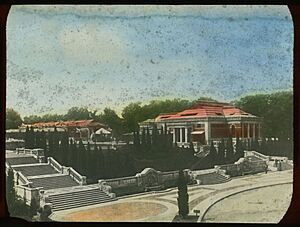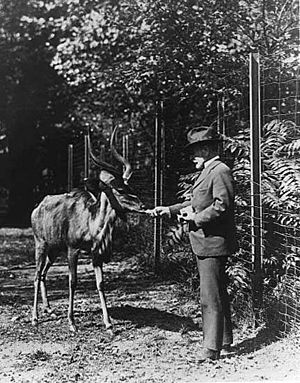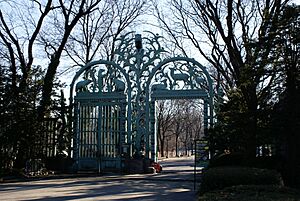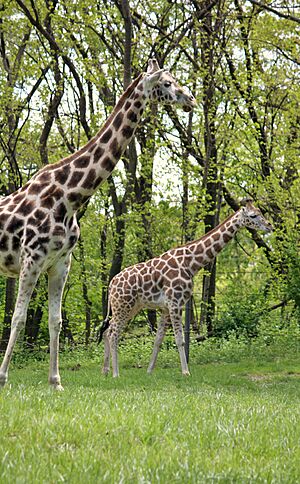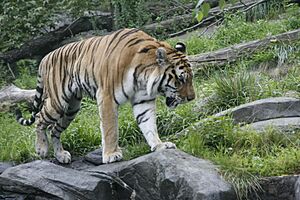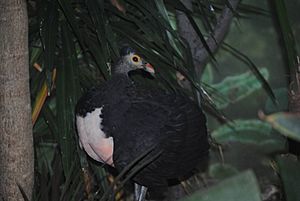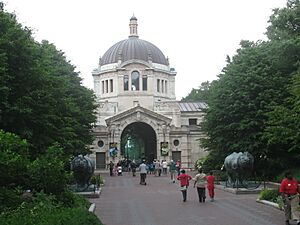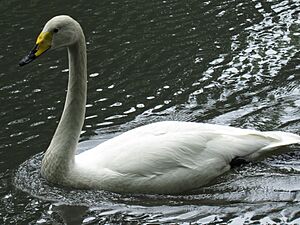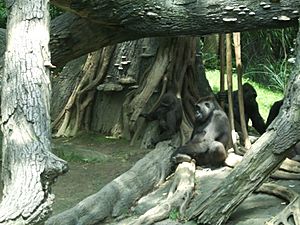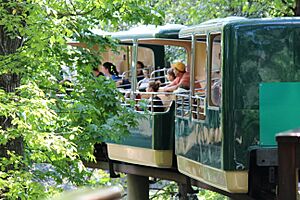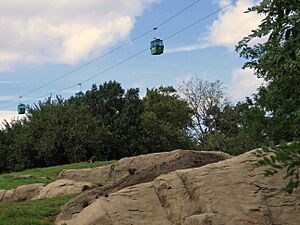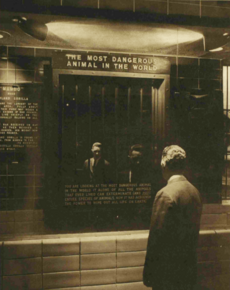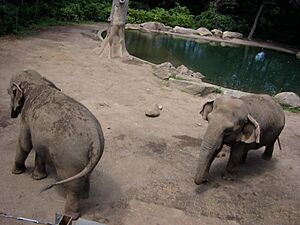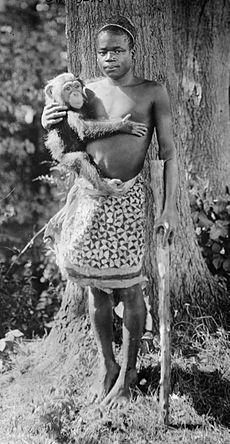Bronx Zoo facts for kids
Bronx Zoo logo
|
|
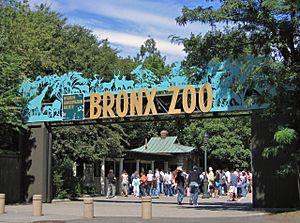
Asia Gate Entrance
|
|
| Date opened | November 8, 1899 |
|---|---|
| Location | 2300 Southern Boulevard, Bronx Park, Bronx, New York 10460, U.S. |
| Land area | 265 acres (107 ha) |
| Coordinates | 40°51′01″N 73°52′42″W / 40.85028°N 73.87833°W |
| No. of animals | 4,000 (2010) |
| No. of species | 650 (2010) |
| Annual visitors | 2+ million |
| Memberships | AZA |
| Major exhibits |
|
The Bronx Zoo is a famous zoo located in Bronx Park in the Bronx, New York. It's one of the biggest zoos in the United States. It covers 265 acres (107 ha) of land with natural habitats for animals. The Bronx River even flows through it! More than 2 million people visit the zoo every year.
The zoo first opened on November 8, 1899. It started with 843 animals in 22 exhibits. Its first director was William Temple Hornaday. From the very beginning, the zoo has worked hard to protect animals. For example, in 1905, the American Bison Society was created there. This group helped save the American bison from disappearing forever. The zoo is also known for its amazing animal collection and exhibits. It's part of a group of zoos and an aquarium managed by the Wildlife Conservation Society (WCS).
History of the Bronx Zoo
How the Zoo Started
In 1895, a group of people formed the New York Zoological Society. This group later became the Wildlife Conservation Society (WCS). Their goal was to create a zoo, learn more about zoology (the study of animals), and protect wildlife.
The Bronx Zoo officially opened on November 8, 1899. It had 843 animals in 22 different exhibits. William Temple Hornaday was the first director, and he worked there for 30 years.
The first buildings, called Astor Court, were designed in a beautiful style called Beaux-Arts. They were built around a large circular pool for sea lions. In 1934, the Rainey Memorial Gates were added. These gates were designed by sculptor Paul Manship.
A special fountain, the Rockefeller Fountain, is now near the Fordham Road Gate. It was originally built in Italy in 1872. William Rockefeller bought it in 1902 and brought it to the zoo in 1903. It's now a recognized New York City landmark.
The zoo has had some rare animals over the years. In the early 1900s, it was one of the few zoos outside Australia to have a thylacine (a type of marsupial that is now extinct). The last thylacine at the zoo died in 1919.
In 1903, the zoo received a pair of Barbary lions. This type of lion is now extinct in the wild. The male lion, Sultan, became very popular. He was even the model for the lion statue on the Rainey Memorial Gates.
In 1916, the Bronx Zoo built the world's first animal hospital inside a zoo. This was a big step for animal care!
The zoo was also the first in North America to show okapi in 1937. Okapis are unique animals related to giraffes.
Recent Zoo Events
In 1960, the zoo was the first in the world to keep a James's flamingo. This species was thought to be extinct until 1957.
The zoo also used to have proboscis monkeys, which are very rare outside of Southeast Asia. The last two in the U.S. were sent to the Singapore Zoo in 2003.
In 1990, the zoo welcomed Rapunzel, a female Sumatran rhinoceros. This species is critically endangered. The zoo was part of a plan to help breed these rhinos. Rapunzel lived at the zoo until she passed away in 2005.
In 2006, the zoo opened new eco-friendly restrooms. These special toilets save a lot of water each year.

Around 2009, the zoo faced some challenges with funding. This meant they had to reduce staff and some animal exhibits. Some areas like World of Darkness and Skyfari had to close.
There was also a plan to bring giant pandas to New York City. However, this project was very expensive. The zoo and city officials decided not to fund it. They wanted to focus on conservation efforts that directly help animals in the wild.
Exhibits and Attractions
The Bronx Zoo has many amazing exhibits. Some are free with a regular ticket, while others cost a little extra.
Free Exhibits
The zoo is home to over 4,000 animals from 650 species. Many of these animals are endangered or threatened. Some exhibits are grouped by animal type, like World of Birds. Others are grouped by where the animals live, like African Plains.
Astor Court
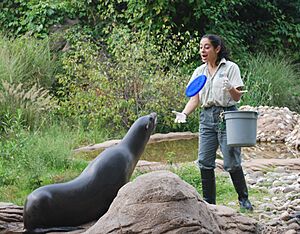
Astor Court is one of the oldest parts of the zoo. It has many of the original buildings. You can see California sea lions in the historic sea lion pool. The former Lion House is now the "Madagascar!" exhibit.
African Plains
In African Plains, you can see lions, African wild dogs, and Grévy's zebras. You'll also spot herds of nyalas and slender-horned gazelles. They share their home with grey crowned cranes and giraffes. This exhibit was one of the first to let visitors see predators and prey in a natural setting.
The Carter Giraffe Building is part of African Plains. Here, you can see giraffes and South African ostriches up close. It's also home to spotted hyenas and aardvarks.
Big Bears
Big Bears features four bears: a male grizzly bear and three ABC Islands bears. These bears were rescued as orphans from Alaska. In 2019, three dholes (wild dogs from Asia) were added to this area.
Gelada Reserve
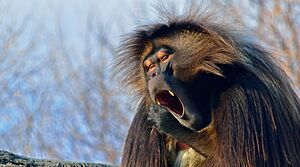
Gelada Reserve opened in 1990. It's a large area that looks like the Ethiopian highlands. It's home to a group of geladas, which are a type of monkey. You can also see Nubian ibex and rock hyrax living together in this hilly exhibit.
Himalayan Highlands
Himalayan Highlands opened in 1986. It looks like the Himalayas region of Asia. The main animals here are the zoo's snow leopards. You can also find red pandas and white-naped cranes. The zoo has had many snow leopard cubs born here.
Madagascar!
Madagascar! opened in 2008. It shows different habitats from the island of Madagascar. You can see many animals from there, including different kinds of lemurs, fossas, Nile crocodiles, and radiated tortoises. The exhibit also teaches visitors about threats to these animals.
Mouse House
The Mouse House is a small building with many tiny mammals, especially rodents. It has areas for both daytime and nighttime animals. You might see fennec foxes, Senegal bushbabies, and long-tailed chinchillas.
Aquatic Bird House
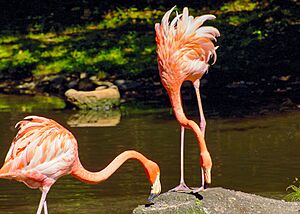
The Aquatic Bird House opened in 1964. It has many open enclosures that look like coastal and wetland habitats. You can see scarlet ibises, roseate spoonbills, and Madagascar crested ibises. Outside, there's a pond with American flamingos.
Russell B. Aitken Sea Bird Aviary
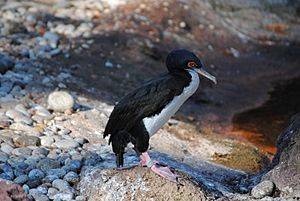
This huge walk-through aviary opened in 1997. It's designed to look like the Patagonian coast. It's 60 feet high and lets birds fly freely. You can see about 100 birds here, mostly Inca terns, along with Magellanic penguins and brown pelicans.
Tiger Mountain
Tiger Mountain opened in 2003. It's a three-acre exhibit for Amur tigers. Sometimes, you might also see Malayan tigers. The exhibit has glass viewing areas and a pool where you can see tigers swimming underwater. The zoo has had success breeding both types of tigers here.
World of Birds
World of Birds is an indoor bird house that opened in 1972. It has several walk-through aviaries. You can learn about how deforestation and the illegal wildlife trade affect wild birds. Some of the birds you might see include maleos, knobbed hornbills, and Andean cock-of-the-rocks.
World of Reptiles
World of Reptiles has been at the zoo since it first opened. It's a long hall with many terrariums. You can see a wide range of species, like American alligators, blue iguanas, king cobras, and Philippine sailfin lizards. The zoo also breeds Kihansi spray toads here, which they saved from extinction.
Pheasant Aviary
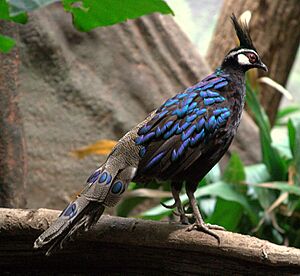
The Pheasant Aviary has many different bird species, especially pheasants. You can see Elliot's pheasant, Lady Amherst's pheasant, and Palawan peacock-pheasants.
Birds of Prey
Birds of Prey has a row of cages for different raptor species. You can see bald eagles, burrowing owls, snowy owls, and an Andean condor. Nearby, there's a pond with black-necked swans and American white pelicans.
Zoo Center
The Zoo Center was built in 1908. It's a beautiful building that used to be the Elephant House. Today, it houses blue tree monitors, Komodo dragons, Aldabra giant tortoises, and southern white rhinoceros.
Bison Range
The Bison Range is in the northeast part of the zoo. It has been a feature since the zoo opened. It was created to help breed Plains bison, which were in danger of disappearing. It's one of the few places in U.S. zoos with a large herd of bison.
Northern Ponds
Northern Ponds is a series of natural ponds. They are home to many waterfowl and other aquatic birds. You can see black-necked cranes, mute swans, and trumpeter swans. Many wild birds also visit these ponds.
Mitsubishi Riverwalk
The Mitsubishi Riverwalk is a path along the Bronx River. It opened in 2004 after a big cleanup project on the river. It helps protect the river's watershed.
Paid Exhibits and Attractions
These attractions require an extra fee or a special ticket.
- Bug Carousel
- Butterfly Garden
- Children's Zoo
- Congo Gorilla Forest
- JungleWorld
- Wild Asia Monorail
- Zoo Shuttle
- Nature Trek
- Bronx Zoo Treetop Adventure
- Dinosaur Safari
- Budgie Landing
Bug Carousel
The Bug Carousel has seats shaped like insects. It was installed in 2005 and is a popular ride.
Butterfly Garden
This is an indoor butterfly conservatory. Visitors can walk through gardens and see many different types of butterflies up close. It's like a maze where you can learn about a butterfly's metamorphosis.
Children's Zoo
The Children's Zoo reopened in 2015 after renovations. It has new exhibits with giant anteaters, pudús, Linne's two-toed sloth, and Asian small-clawed otters. You can also see farm animals like Nubian goats, sheep, and pigs.
Congo Gorilla Forest
Congo Gorilla Forest is a 6.5-acre (2.6 ha) rainforest exhibit. It's home to about 20 western lowland gorillas. You can also see Angolan colobus monkeys and mandrills. This exhibit helps raise money for gorilla conservation in Africa.
JungleWorld
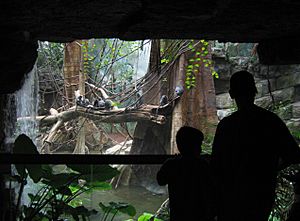
JungleWorld is a huge indoor tropical jungle. It has nearly 800 species, including Asian small-clawed otters, Javan lutungs, northern white-cheeked gibbons, and Malayan tapirs. You can walk through different areas like mangrove swamps and rainforests.
Wild Asia Monorail
The monorail ride takes you through a 40-acre (16 ha) area that looks like Asia. You can see animals like tigers, Indian elephants, rhinos, and wild horses. Some animals can only be seen on this ride.
Nature Trek
Nature Trek opened in 2017. It has twelve covered rope bridges and elevated tunnels. There's also a play area on the ground with a sandbox and water sprinklers.
Bronx Zoo Treetop Adventure
This area opened in 2017 and has rope courses and a zip-line over the Bronx River. It's a separate attraction with its own fee.
Dinosaur Safari
Dinosaur Safari takes visitors on a ride through a wooded area. It features animatronic dinosaurs from different time periods. You can see Triceratops, Brachiosaurus, and even a Dilophosaurus that spits water!
Budgie Landing
Budgie Landing opened in 2023. It's an exhibit with 1,000 budgerigars. You can pay a small fee to enter and even get a feeding stick to feed the birds.
Former Exhibits
World of Darkness
World of Darkness opened in 1969. It was the first major exhibit designed for nocturnal animals. It used special red lights to let visitors see animals that are active at night. This exhibit closed in 2009 due to budget cuts.
Rare Animal Range
Rare Animal Range was a trail that showed highly endangered species. It had animals like guanaco and blue-eyed black lemurs. This exhibit also closed in 2009.
Skyfari
The Skyfari was a popular gondola lift that took visitors high above the zoo. It offered great views of African Plains and other exhibits. It closed permanently in 2009 after 35 years of operation.
Monkey House
The Monkey House, which opened in 1901, closed in 2012 after 111 years. It was home to many different types of monkeys. Some of these primates were moved to other parts of the zoo or to other New York City zoos.
The Most Dangerous Animal in the World
This exhibit debuted in 1963. It was a cage with a mirror inside. The words "The Most Dangerous Animal in the World" were printed on top. It was meant to make visitors think about the impact humans have on the planet.
WCS's Run for the Wild
Since 2008, the zoo has hosted the "Run for the Wild" event every April. It's a 5k run that raises money and awareness for the Wildlife Conservation Society's conservation programs. Each year, the event focuses on a different endangered species or animal group. Participants get free entry to the zoo and its paid exhibits.
Conservation Efforts
The Bronx Zoo is a leader in animal conservation.
In 1905, the zoo's first director, William Temple Hornaday, helped create the American Bison Society. This group worked to save the American bison from extinction. They bred bison in captivity and reintroduced them into the wild. This effort was very successful.
In 2005, the Wildlife Conservation Society brought the American Bison Society back. They are still working to help bison populations grow.
In 2007, the zoo successfully reintroduced three Chinese alligators into the wild. These alligators even started breeding naturally in the wild! This was a big achievement for the zoo's efforts to help this species.
In 2010, the zoo adopted four abandoned brown bear cubs. These cubs were rescued from Alaska and Montana. The zoo helps care for animals that cannot survive in the wild.
The zoo also has an "assurance colony" of Kihansi spray toads. This species disappeared from their native Tanzania. The zoo is helping to keep them from going extinct.
Incidents
Animal Incidents
In 2007, there was an incident in JungleWorld. A group of oriental small-clawed otters attacked and drowned a Javan lutung monkey. After this, the otters were moved to a different area.
The zoo has had a few animal escapes over the years. In 1902, a jaguar escaped but was caught. In 2011, a venomous Egyptian cobra escaped from its off-exhibit area. It was found six days later inside the reptile house. In 2023, an Indian peafowl named Raul briefly escaped but flew back into the zoo.
Happy the Elephant
Happy is an Indian elephant who came to the zoo in 1977. For many years, she lived with another elephant named Grumpy. After Grumpy passed away, Happy was paired with another elephant, Sammy. When Sammy also passed away, Happy was left without a companion.
Elephants are very social animals. Because Happy has lived without other elephants, some animal rights groups have criticized the zoo. They believe Happy should be moved to an elephant sanctuary. However, the zoo believes moving her would be too stressful. They say she has strong bonds with her keepers and is well-adjusted to her home at the zoo.
In 2022, a court case was heard about Happy. The court ruled that the legal term "person" does not apply to nonhuman animals. This meant Happy could not be moved to a sanctuary based on that legal argument.
Ota Benga
In 1906, a man named Ota Benga from the Mbuti pygmy group was brought to the zoo. He was displayed as an exhibit, sometimes in the Monkey House. Zoo officials at the time thought this was a good idea for visitors.
However, African-American clergymen and others immediately protested. They said it was wrong to display a human being like an animal. They argued that it was dehumanizing. In response to the protests, Ota Benga was removed from the zoo's public display.
The Wildlife Conservation Society (WCS), which runs the Bronx Zoo, apologized in 2020 for the zoo's treatment of Ota Benga. They recognized that his display was a terrible act of racism.
Entrances (gates)
- Asia Gate (walk in) Boston Road
- Bronx River Parkway Gate (parking)
- Fordham Road Gate (parking)
- Southern Boulevard Gate (parking)
Notable people
- E. R. Sanborn (1869–1947), first official photographer
See also
 In Spanish: Zoológico del Bronx para niños
In Spanish: Zoológico del Bronx para niños


